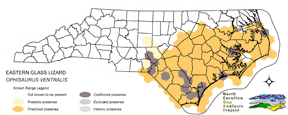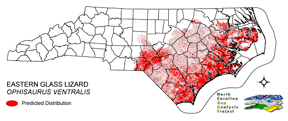
| Taxa: |
| Order: |
| Family: |
| Reptilia |
| Squamata |
| Anguidae |
| NatureServe Global Rank: |
| NatureServe State (NC) Rank: |
| G5 |
| S4 |
| Federal Status: |
| NC State Status: |
| --- |
| --- |


| Land Unit |
| US Fish & Wildlife Service |
| US Forest Service |
| US National Park Service |
| US Department of Defense |
| NC State Parks |
| NC University System |
| NC Wildlife Res. Com. |
| NC Forest Service |
| NC Div. of Coastal Mgmt. |
| Local Governments |
| Non-Governmental Org. |
| Other Public Lands |
| Private Lands |
| GAP Status 1-2 |
| All Protected Lands |
| Statewide |
| Hectares |
| 77,027.40 |
| 58,873.86 |
| 114,746.85 |
| 3,002.67 |
| 4,770.36 |
| 29,179.80 |
| 66,461.85 |
| 11,406.60 |
| 6,346.17 |
| 496.35 |
| 11,637.81 |
| 794.07 |
| 2,049,649.92 |
| 155,384.91 |
| 383,557.41 |
| 2,434,393.71 |
| Acres |
| 190,338.81 |
| 145,480.45 |
| 283,545.59 |
| 7,419.76 |
| 11,787.81 |
| 72,104.84 |
| 164,230.78 |
| 28,186.32 |
| 15,681.72 |
| 1,226.51 |
| 28,757.65 |
| 1,962.19 |
| 5,064,794.27 |
| 383,964.40 |
| 947,790.82 |
| 6,015,516.69 |
| % of Dist. on |
| Prot. Lands |
| 20.1 % |
| 15.3 % |
| 29.9 % |
| 0.8 % |
| 1.2 % |
| 7.6 % |
| 17.0 % |
| 3.0 % |
| 1.7 % |
| 3.0 % |
| 3.0 % |
| 0.2 % |
| < 0.1 % |
| 40.5 % |
| ----- |
| ----- |
| % of Dist. on |
| All Lands |
| 3.2 % |
| 2.4 % |
| 4.7 % |
| 0.1 % |
| 0.2 % |
| 1.2 % |
| 2.7 % |
| 0.5 % |
| 0.3 % |
| < 0.1 % |
| 0.5 % |
| < 0.1 % |
| 84.2 % |
| 6.4 % |
| ----- |
| ----- |
|
This species is found locally in the sandhills, coastal plain, and barrier islands (Martof et al 1980, Palmer & Braswell 1995). Eastern glass lizards are typically found in mesic or damp environments such as pine flatwoods, maritime forests, scrubby woodlands, wet meadows, or damp grassy areas in sandy habitats (Mitchell 1994, Palmer & Braswell 1995). Areas around ponds, marshes, and estuaries, as well as ruderal environments in fields and vacant lots are also preferred habitat (Martof et al 1980). Eastern glass lizards forage underground and in the cover of grass for arthropods, snails, small lizards and snakes (Mitchell 1994, Palmer & Braswell 1995). NATURE SERVE GLOBAL HABITAT COMMENTS: Damp grassy areas, open woods (mesic hammock, pine flatwoods; reported from tropical hammock in Florida by Schwartz and Henderson 1991); under debris in fields and vacant lots near ponds, marshes, and estuaries. Favors areas with sandy friable soils and abundant shelter on ground. Semifossorial. Eggs are laid under or at base of grass clumps (Ashton and Ashton 1985) or under debris on ground (Mount 1975). |
| Code | Name | Description | NC Natural Heritage Program Equivalent |
| 124 | Maritime Scrubs and Tidal Shrublands | Coastal shrubs including wax-myrtle, swamp rose, alder, yaupon, and greenbriar. | Maritime Shrubs, Salt Shrub |
| 121 | Maritime Pinelands | Loblolly forests and woodlands of the outer coastal plain. | Estuarine Fringe Loblolly Pine Forest |
| 17 | Maritime Forests and Hammocks | Maritime forests and woodlands dominated by live or sand laurel oak. Estuarine Fringe forests dominated by loblolly pine. | Coastal Fringe Evergreen Forest, Maritime Deciduous Forest, Maritime Deciduous Forest |
| 173 | Coastal Plain Riverbank Shrubs | Shrub dominated riverbanks, commonly dominated by willows and/or alders. | Sand and Mud Bar |
| 158 | Coastal Plain Nonriverine Wet Flat Forests | Loblolly pine - Atlantic white-cedar - red maple - swamp tupelo saturated forests as well as forests dominated by loblolly, sweetgum, and red maple in non-riverine flats. | Non-riverine Wet Hardwood Forest |
| 87 | Pocosin Woodlands and Shrublands | Includes pond pine woodland, low pocosin and high pocosin shrub dominated areas. Canebrakes and bay forests may be present. | Pond Pine Woodlands, Peatland Canebrake, Small Depression Pocosin |
| 67 | Wet Longleaf or Slash Pine Savanna | Wet flatwoods and pine savannas, typically dominated by longleaf pines, but slash or pond pines may be the dominant pines. | Wet Pine Flatwoods |
| 97 | Mesic Longleaf Pine | Longleaf pine woodlands without a major scrub oak component. Slash or loblolly pines may be present as well. | Mesic Pine Flatwoods |
| 42 | Xeric Longleaf Pine | Sandhills including a range of longleaf pine density from predominantly wiregrass, scrub oak dominated to true longleaf pine woodland. This does not include mesic or saturated flatwood types. | Xeric Sandhill Scrub, Pine/Scrub Oak Sandhill, Coastal Fringe Sandhill |
| 46 | Xeric Oak - Pine Forests | Mixed forest dominated by yellow pines with white or northern red oaks co-dominating. | Pine Oak Heath |
| 267 | Riverbank Shrublands | Riverside shrubs with temporarily flooded hydrologies. Found in the both the Mountains and Piedmont. Containing dominants such as smooth alder and a Carolina or black willows. | Sand and Mud Bar |
| 269 | Floodplain Wet Shrublands | Saturated shrublands of the Piedmont, includes buttonbush, swamp-loosestrife, decodon and alders. | Piedmont/mountain Semipermanent Impoundment |
| 382 | Dry Mesic Oak Pine Forests | Mixed forests of the coastal plain and piedmont. Includes loblolly pine with white, southern red and/or post oak and loblolly with water oak. On basic sites of the piedmont, eastern red cedar may co-occur with post, black, and blackjack oaks. | Dry Mesic Oak Hickory Forest, Xeric Hard Pan Forest, Chestnut Oak Forest, Dry Mesic Oak Hickory Forest, Dry Oak Hickory Forest |
| 20 | Coniferous Regeneration | Regenerating pine stands. Predominantly loblolly pine, but slash and longleaf stands occur as well. | No equivalent |
| 21 | Coniferous Cultivated Plantation (natural / planted) | Managed pine plantations, densely planted. Most planted stands are loblolly, but slash and longleaf occur as well. | No equivalent |
| 205 | Agricultural Pasture/Hay and Natural Herbaceous | Farm fields used for pasture grass or hay production, as well as old fields dominated by native and exotic grasses. | No equivalent |
|
Schwartz, A., and R. W. Henderson. 1991. Amphibians and Reptiles of the West Indies:Descriptions, Distributions, and Natural History. University of Florida Press, Gainesville, Florida. xvi + 720 pp.
Mitchell, J. C. 1994. The reptiles of Virginia. Washington, DC: Smithsonian Institution Press. Palmer, W. M., and A. L. Braswell. 1995. Reptiles of North Carolina. North Carolina State Museum of Natural Sciences, University of North Carolina Press, Chapel Hill, North Carolina. McConkey, E. H. 1954. A systematic study of the North American lizards of the genus OPHISAURUS. Am. Midl. Nat. 51:133-169. Mount, R. H. 1975. The Reptiles and Amphibians of Alabama. Auburn University Agricultural Experiment Station, Auburn, Alabama. vii + 347 pp. Behler, J. L., and F. W. King. 1979. The Audubon Society field guide to North American reptiles and amphibians. Alfred A. Knopf, New York. 719 pp. Martof, B. S., W. M. Palmer, J. R. Bailey, and J. R. Harrison, III. 1980. Amphibians and reptiles of the Carolinas and Virginia. University of North Carolina Press, Chapel Hill, North Carolina. 264 pp. Ashton, R. E., Jr., and P. S. Ashton. 1985. Handbook of reptiles and amphibians of Florida. Part two. Lizards, turtles & crocodilians. Windward Pub., Inc., Miami. 191 pp. Holman, J. A. 1971. Ophisaurus ventralis. Cat. Am. Amph. Rep. 115.1-115.2. Mitchell, J. C. 1991. Amphibians and reptiles. Pages 411-76 in K. Terwilliger (coordinator). Virginia's Endangered Species:Proceedings of a Symposium. McDonald and Woodward Publishing Company, Blacksburg, Virginia. |
For more information please contact them at:
NC-GAP Analysis Project
Dept. of Zoology, NCSU
Campus Box 7617
Raleigh, NC 27695-7617
(919) 513-2853
www.basic.ncsu.edu/ncgap